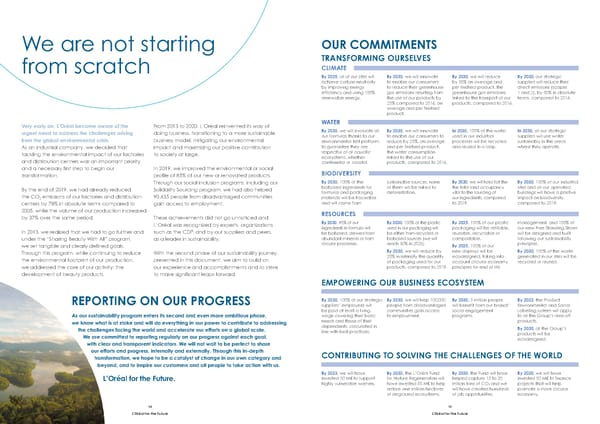15 L’Oréal for the Future 14 L’Oréal for the Future We are not starting from scratch Very early on, L’Oréal became aware of the urgent need to address the challenges arising from the global environmental crisis. As an industrial company, we decided that tackling the environmental impact of our factories and distribution centers was an important priority and a necessary first step to begin our transformation. By the end of 2019, we had already reduced the CO 2 emissions of our factories and distribution centers by 78% in absolute terms compared to 2005, while the volume of our production increased by 37% over the same period. In 2013, we realized that we had to go further and, under the “Sharing Beauty With All” program, we set tangible and clearly defined goals. Through this program, while continuing to reduce the environmental footprint of our production, we addressed the core of our activity: the development of beauty products. From 2013 to 2020, L’Oréal reinvented its way of doing business, transitioning to a more sustainable business model, mitigating our environmental impact and maximizing our positive contribution to society at large. In 2019, we improved the environmental or social profile of 85% of our new or renovated products. Through our social inclusion programs, including our Solidarity Sourcing program, we had also helped 90,635 people from disadvantaged communities gain access to employment. These achievements did not go unnoticed and L’Oréal was recognized by experts, organizations such as the CDP, and by our suppliers and peers, as a leader in sustainability. With the second phase of our sustainability journey, presented in this document, we aim to build on our experience and accomplishments and to strive to make significant leaps forward. As our sustainability program enters its second and even more ambitious phase, we know what is at stake and will do everything in our power to contribute to addressing the challenges facing the world and accelerate our efforts on a global scale. We are committed to reporting regularly on our progress against each goal, with clear and transparent indicators. We will not wait to be perfect to share our efforts and progress, internally and externally. Through this in-depth transformation, we hope to be a catalyst of change in our own category and beyond, and to inspire our customers and all people to take action with us. L’Oréal for the Future. REPORTING ON OUR PROGRESS OUR COMMITMENTS TRANSFORMING OURSELVES By 2025, all of our sites will achieve carbon neutrality by improving energy efficiency and using 100% renewable energy. By 2030, we will innovate to enable our consumers to reduce their greenhouse gas emissions resulting from the use of our products by 25% compared to 2016, on average and per finished product. By 2030, we will reduce by 50% on average and per finished product, the greenhouse gas emissions linked to the transport of our products, compared to 2016. By 2030, our strategic suppliers will reduce their direct emissions (scopes 1 and 2), by 50% in absolute terms, compared to 2016. CLIMATE EMPOWERING OUR BUSINESS ECOSYSTEM By 2030, 100% of our strategic suppliers’ employees will be paid at least a living wage covering their basic needs and those of their dependents, calculated in line with best practices. By 2030, we will help 100,000 people from disadvantaged communities gain access to employment. By 2030, 3 million people will benefit from our brands’ social engagement programs. By 2022, the Product Environmental and Social Labelling system will apply to all the Group’s rinse-off products. By 2030, all the Group’s products will be ecodesigned. CONTRIBUTING TO SOLVING THE CHALLENGES OF THE WORLD By 2023, we will have invested 50 M € to support highly vulnerable women. By 2030, the L’Oréal Fund for Nature Regeneration will have invested 50 M € to help restore one million hectares of degraded ecosystems. By 2030, the Fund will have helped capture 15 to 20 million tons of CO 2 and we will have created hundreds of job opportunities. By 2030, we will have invested 50 M € to finance projects that will help promote a more circular economy. By 2030, we will evaluate all our formulas thanks to our environmental test platform, to guarantee they are respectful of all aquatic ecosystems, whether continental or coastal. By 2030, we will innovate to enable our consumers to reduce by 25%, on average and per finished product, the water consumption linked to the use of our products, compared to 2016. In 2030, 100% of the water used in our industrial processes will be recycled and reused in a loop. In 2030, all our strategic suppliers will use water sustainably in the areas where they operate. WATER By 2030, 100% of the biobased ingredients for formulas and packaging materials will be traceable and will come from sustainable sources, none of them will be linked to deforestation. By 2030, we will hold flat the the total land occupancy vital to the sourcing of our ingredients, compared to 2019. By 2030, 100% of our industrial sites and all our operated buildings will have a positive impact on biodiversity, compared to 2019. BIODIVERSITY By 2030, 95% of our ingredients in formula will be biobased, derived from abundant minerals or from circular processes. By 2030, 100% of the plastic used in our packaging will be either from recycled or biobased sources (we will reach 50% in 2025). By 2030, we will reduce by 20% in intensity the quantity of packaging used for our products, compared to 2019. By 2025, 100% of our plastic packaging will be refillable, reusable, recyclable or compostable. By 2025, 100% of our new displays will be ecodesigned, taking into account circular economy principles for end of life management, and 100% of our new Free Standing Stores will be designed and built following our sustainability principles. By 2030, 100% of the waste generated in our sites will be recycled or reused. RESOURCES
 Sustainability Commitment Page 7 Page 9
Sustainability Commitment Page 7 Page 9